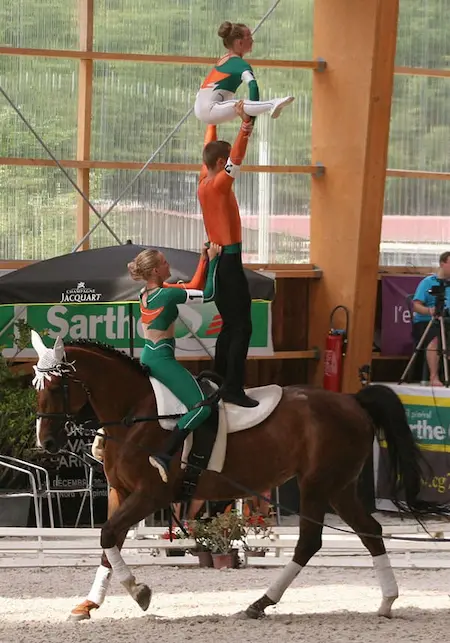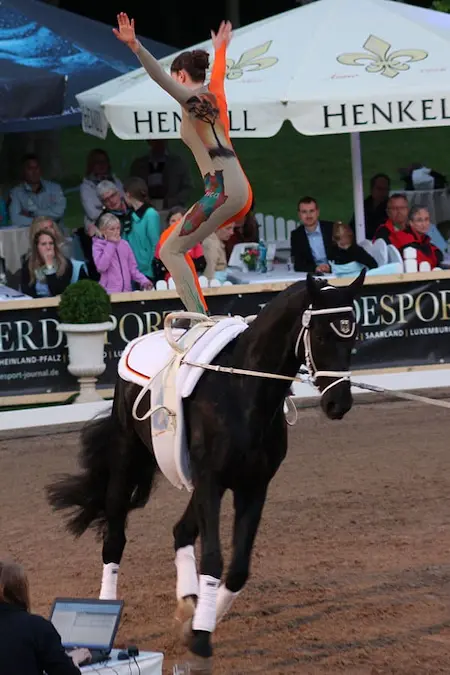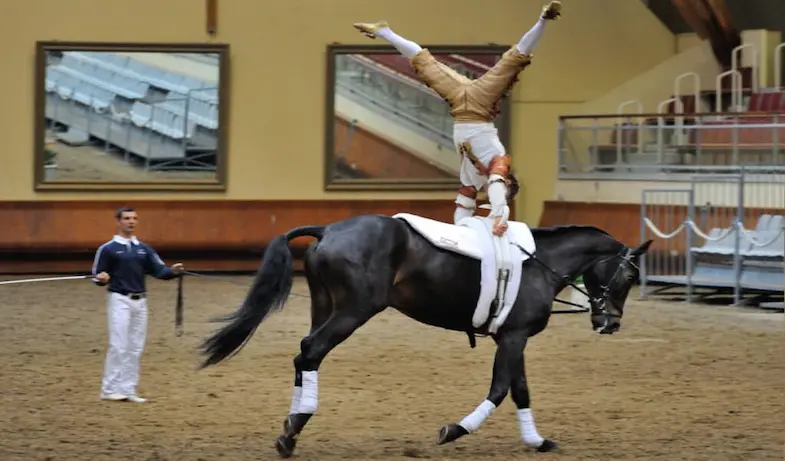There’s plenty of debate as to whether equestrian vaulting is a sport or an art but whatever side of the fence you’re on you can’t fail to agree that it’s graceful and impressive to watch. If you ever went to the circus when you were younger chances are you’ve seen a vaulting display.
You might think that equestrian vaulting (or vaulting as its also known) is a new sport that has its history in the circus ring and that it will disappear as quickly as it started but this couldn’t be further from the truth. Yes, the sport, which is lovingly referred to as gymnastics on horseback, does have a connection to the circus but its real history goes back over two thousand years!
What is equestrian vaulting?
Poetic gymnastics on horseback is the perfect way to describe equestrian vaulting because not only are you performing an acrobatic display while ‘riding’ a horse, the idea is to promote a harmonious connection between the horse and gymnast that creates a jaw-dropping display of skill, balance, trust, and precision.
A vaulting ‘team’ is made up of a horse, a lunger (or longeur, who controls the horse), and one or more vaulter (sometimes known as gymnasts or athletes). Many of the maneuvers are carried out at a canter although when practicing they’re often performed at a walk.
The benefits of vaulting though go beyond that of being just a sport, it can be used as a therapeutic aid for children and adults who have issues with their balance or attention and can even be used to help those with impaired motor skills. Therapeutic vaulting has even been successfully used to help children and young adults improve their social skills
The history of equestrian vaulting
Nobody is quite sure of the origins of equestrian vaulting but it’s believed to have either come from ancient Crete where people used to ‘bull-leap’ (a type of non-violent bull fighting where acrobats leap over the back of a charging bull), or from ancient Roman games where acrobats would display their skills on fast-moving horses. Whichever of these are true, people have been performing these elegant gymnastic like moves on (and over) the backs of horses for over two millennia.
While the birth of the sport dates back thousands of years, the modern discipline that we know today evolved from a form of riding drill known as la voltige (which translates to mean acrobatics). La voltige was especially popular with cavalry riders and was often used as a way of improving a rider’s agility.
After the Middle Ages, the sport’s popularity began to wane until just after the Second World War when it was used as a way to introduce children to equestrian sports in post-war Germany. Since then it’s gone from strength to strength and was even an Olympic sport at the 1920 Antwerp games.
Now officially recognized as a discipline by the FEI, there have been vaulting championships held at every World Equestrian Games since 1990.
Is equestrian vaulting dangerous?
Like all sports, especially those involving living creatures, there is an element of risk involved in equestrian vaulting but despite that, it’s actually a very safe sport and is in fact regarded as being safer than many other sports. The reason for this is in part the fact that although the horse is moving the gymnast doesn’t have to think about controlling the horse, this means that while the lunger (or longeur) is controlling the horse the gymnast is free to concentrate on their balance and position.
Many vaulting clubs adhere to what’s known as the ‘three points of vaulting safety’ which address the main risk factors associated with equestrian disciplines. The three main risk factors they deal with are:
- Loss of control by the rider – 60% of injuries are caused by the rider losing control and because somebody else is controlling the horse the rider (or gymnast in this case) can focus solely on what they’re doing at that moment.
- Suitability of the environment and horse – In vaulting the environment is very controlled (it’s always in an enclosed arena with the horse on a long line) and the horse is highly trained there are no outside factors that can result in the gymnast losing control and falling.
- Safety knowledge – As well as the horse being trained the gymnast is also ‘trained’ to, they’re trained to keep their balance, improve their suppleness, and move with the rhythm of the horse. This is curial to increasing the gymnast’s confidence when will greatly reduce the risk of falling.
What are the equestrian vaulting moves?
There are a number of compulsory exercises that must be performed in any competition:
- Mount – The vaulter will stand with the lunger and move towards the horse, hold the handles, and vault onto the horse’s back. This is a test of the vaulter’s strength, flexibility, and timing.
- Basic seat – The vaulter will sit across the horse with their arms extended to the sides with the toes pointing downwards. This is designed to improve the vaulter’s balance by forcing them to sit evenly without gripping with their legs.
- Flag – This is where the vaulter will kneel on the horse with the opposite arm (or hand) positioned on the horse’s withers. They’ll then extend the opposite arm and leg out as much as possible. The benefit of this maneuver is to improve the vaulter’s balance, coordination, and spatial awareness.
- Mill – Designed to improve flexibility, strength, and balance, it involves the rider moving their leg over the horse (with their leg being straight and the toes pointing over the horse’s body. The rider will move a leg over the horse with every footfall the horse makes.
- Scissors – The vaulter will swing from the seat to do a handstand then turn their hips towards the lunger and sit back before bringing their legs back up, crossing them over and returning back to the basic seat. The idea of this maneuver is to strengthen the vaulter’s arms as well as their core and to improve their balance and flexibility.
- Stand – As you can probably guess this involves the vaulter standing on the horse’s back, they should also have their arms stretched out to the sides. Like many other maneuvers, this is designed to promote the vaulter’s balance but it’ll also improve their symmetry and core strength.
- Flank – The vaulter needs to move from a basic seat to a handstand before bringing their legs down to form an upside-down V and then lowering themselves to the side of the horse. They then need to support their weight before bringing their legs back to the other side of the horse and pushing away with their hands to gently land on the ground with their knees bent.
Equestrian vaulting competitions
Competitive vaulting is open to all levels of as well as both individuals, teams, and pairs. The only real difference between beginner competitions and those for experienced vaulters is the speed, beginners always compete at a walk while the more experienced vaulters compete at a canter. With both levels the horse is on a long line and works in a minimum of a 15 meter (50 foot) circle, all competitions will judge the horse and rider out of ten (the vaulter will account for 75% of the score while the horse will make up the other 25%).
There are three categories for all entrants with the main difference, other than the number of vaulters, being the time taken to perform.
Individual – Also know Kür, the routine lasts for one minute
Pas-de-deux – Translating to mean ‘step of two’, this is for pairs and is a two minute program.
Team – Three vaulters compete in team events which last for four minutes
How to get started in equestrian vaulting
If you’re thinking about giving vaulting a go then the good news is that you don’t need any riding experience at all (in fact some people argue that being able to ride can be a handicap at first) nor does it matter what age you are, as long as you have a basic level of fitness.
There are plenty of clubs and groups that will be happy to teach you, you can get a list from your national association:
- American Vaulting Association
- British Equestrian Vaulting
- Vault Canada
- Equestrian Vaulting Australia
- Vaulting South Africa
Everybody will have their own thoughts and suggestions for getting started in the sport but when I gave it a go (admittedly I’ve only tried it once) I quickly learned the following:
- Don’t wear baggy clothes – You should wear clothes (such as leggings) that are comfortable and stretchy but tight. This will prevent them from getting caught.
- Secure your footwear – Ballet shoes are ideal but if you don’t have a pair then tie your footwear on with some ribbon. This will prevent them from falling off.
- Have confidence – You might think that there’s no way you’ll be able to kneel (or even stand) on a moving horse without holding on but you’ll soon get the hang of it.
- Forget your personal space – Vaulting is a close sport and you’ll need to be comfortable hanging onto other people as well as having other people holding onto you.
- Don’t try to ride the horse – In vaulting there’s a lunger (or longeur) that will control the horse for you so you don’t need to worry about doing that yourself.
Further reading
- Improving your horse’s confidence
- How to improve your core strength
- Am I too old to learn to ride?
- Learn to ride in easy steps
- Getting back in the saddle
- How to be a better rider
- Do horses like being ridden?
- How to strengthen your horse’s back
- 0 unusual horse sports
- What’s the difference between Western & English
I hope you found this article helpful. If you did I’d be grateful if you could share it please as it would really help me.
Recommended products
Over the years I have tried hundreds of different horsey products, from various blankets and halters to different treats. Some I’ve loved, others I’ve hated but I thought I’d share with you my top all-time favorite products, the ones I never leave the yard without. I’ve included links to the products (which are in no particular order) that I really think are great.
- Horse Knots by Reference Ready – If you’re like me and enjoy pocket reference guides then you’ll love this knot tying guide. These handy cards can easily fit in your pocket or attach to the saddle for quick reference. They’re waterproof, durable and are color coded to make them easy to follow.
- Mane ’n Tail Detangler – Even if you never show your horse you’ll need to detangle his tail from time to time (and possibly his mane too) which is always a challenging chore! I’ve found that if I run a little bit of detangler through my horse’s tails every few days it stops them from getting matted up and makes combing them easy, even if they’re coated in mud. I don’t know if I should admit to this or not but it also works wonders on my hair.
- TAKEKIT Pro clippers – Over the years I’ve tried a lot of different clippers and while some were obviously better than others I found these to be by far the best. They are heavier than a lot of other clippers but for me, that’s a good thing, it makes them feel more sturdy and hardwearing. On top of that they have a range of speeds so are just as good for clipping your horse’s back as they are his face. I also like the fact that they come in a handy carry case but that’s not for everybody. The company that makes them is super good and incredibly helpful too, a real bonus these days. The only thing I wasn’t keen on was the fact that it doesn’t come with any oil, but that’s not a major problem as it’s not difficult to buy lubricant.
- Shire’s ball feeder – There are so many boredom buster toys out there but I like to use these every day, regardless of whether or not my horses are bored. I find that it helps to encourage my horses to problem solve by rewarding them with treats (or pieces of fruit) but it also mimics their natural grazing behavior which helps to keep them calm and de-stressed.
- Horse safe mirror – This is a strange one that many people are surprised about but I like to put horse safe mirrors in the trailers as well as in the quarantine stalls. It helps to prevent the feeling of isolation by giving the impression of other horses being around. Being herd animals horses can get extremely stressed when they feel that they’re on their own but with these stick-on mirrors, they believe that at least one other horse is with them.
- Rectal thermometer – I know this isn’t glamourous at all but it’s vital for your horse’s well-being to be able to check their temperature and a rectal thermometer is the easiest way of doing this which is why I’ve added it to the list.
Shopping lists
I’ve also put together a few shopping lists of essential items that I’ve found helpful over the years. I’ve broken the lists down into different categories rather than put everything in one massive list 😉




